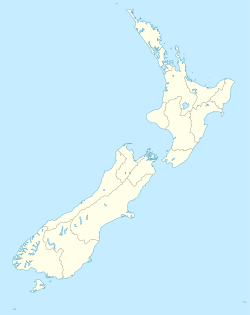Te Awamutu
| Te Awamutu | ||
| Geographical location | ||
|
|
||
| Coordinates | 38 ° 1 ′ S , 175 ° 20 ′ E | |
| Region ISO | NZ-WKO | |
| Country |
|
|
| region | Waikato | |
| District | Waipa District | |
| Ward | Te Awamutu Ward | |
| Administrative headquarters | Seat of administration for the Waipa District | |
| Residents | 10 205 (2013) | |
| height | 57 m | |
| Post Code | 3800 | |
| Telephone code | +64 (0) 7 | |
| UN / LOCODE | NZ TAW | |
| website | www.teawamutu.co.nz | |
Te Awamutu is a town in the Waipa District of the Waikato regionon the North Island of New Zealand . The city is the seat of the Waipa District Council .
Origin of name
The name of the city means something like "the end of the river" in the Māori language , which probably indicated that the Mangapiko Stream could still be canoeed up to the area where the city is today however not.
geography
The city is located around 25 kilometers south of Hamilton and about 18 km southwest of Cambridge in the great plain of Punui River and numerous streams (streams), one of the streams , the Mangapiko stream runs right through the city. About 20 km west of Te Awamutu is the 962 m high Mount Pirongia , which is not only the highest mountain in the district, but in the entire region. To the north and east lies the fertile Waikato Plains .
history
In the 14th century the Waikato region was settled by the descendants of the Tainui Waka (canoe). 1839 British missionary who established the Church of England , Benjamin Yates Ashwell first missionary station in the area. In 1841 he was followed by the Reverend John Morgan , who taught the Māori agricultural techniques and as a result the region developed so well that income could soon be sold as far as Auckland .
In the New Zealand Wars in the 19th century the whole region played an important role, Te Awamutu itself served as a garrison town for the European settlers.
population
In the 2013 census, the city had 10,205 inhabitants, 5.0% more than in the 2006 census.
economy
Te Awamutu is the economic center of the agricultural area, the administrative center of the district and "New Zealand's Rose Capital", as the city calls itself. With around 3000 rose bushes, a rose garden and an annual rose festival, one tries to maintain the image it has given itself and to market it economically. Agriculture in the surrounding area is characterized by milk production and sheep breeding, and in the city itself companies offer technical products and fertilizers for agriculture. Milk processing also takes place in the urban area.
Infrastructure
Road traffic
The New Zealand State Highway 3 runs through Te Awamutu and connects the city to the north with Hamilton and to the south with Otorohanga .
Rail transport
The railway line of the North Island Main Trunk Railway runs through the western part of the city and has a train station and industry in the district.
Personalities
- Spencer P. Jones (1956–2018), singer-songwriter and rock guitarist
- Tim and Neil Finn (* 1958), both musicians who had great success with the band Split Enz in New Zealand in the 1970s and 1980s, before becoming known worldwide with the band Crowded House .
- Brad Butterworth , OBE (born 1959), racing sailor
- Andrew Nicholson (* 1961), eventing rider
- Peter Latham (* 1984), racing cyclist
- Rushlee Buchanan (* 1988), cyclist, New Zealand road champion
- Michaela Drummond (* 1998), racing cyclist
See also
literature
- Helga Neubauer: Te Awamutu . In: The New Zealand Book . 1st edition. NZ Visitor Publications , Nelson 2003, ISBN 1-877339-00-8 , pp. 414-416 .
Web links
- Homepage . Te Awamutu Online,accessed October 17, 2017.
Individual evidence
- ↑ a b 2013 Census QuickStats about a place : Te Awamutu West, Central, East, South . Statistics New Zealand , accessed on October 17, 2017 (English, StatsMap: Meshblock analysis from the interactive map).
- ^ Neubauer: Te Awamutu . In: The New Zealand Book . 2003, p. 416 .
- ↑ a b Topo250 maps . Land Information New Zealand , accessed October 17, 2017 .
- ↑ a b Neubauer: Te Awamutu . In: The New Zealand Book . 2003, p. 415 .
